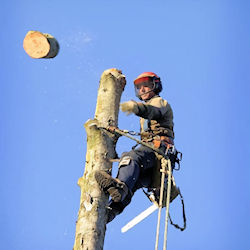31.C Felling.
31.C. 01 Prior to felling operations, the employee must consider the associated hazards that may include, but are not limited to:
- Tree size (e.g., able to fit in landing zone);
- Selected direction of fall;
- Felling path obstacles to avoid or clear;
- Vines or interlocking limbs;
- Species and shape of tree;
- Lean of tree;
- Loose limbs, hangers, broken tops, chunks, or other overhead material;
- Wind force and direction;
- Decay, cavities, or weak spots throughout the tree;
- Location of any electrical conductors or other wires;
- Tree cables, bracing, lightning protection, or other tree hardware;
- Size and terrain characteristics or limitations of work area;
- Potential for flying debris from tree impact;
- Adequate retreat path;
- Evidence of bees or wildlife habitation in tree;
- Poisonous plants, water hazards;
- Ability to control access to work site;
- Authority to remove tree;
- Quality of wood fiber in hinge area;
- Root mass stability;
- Ice or snow load;
- Throw-back or bounce-back potential;
- Potential for spring poles;
- Lodged trees or dead snags in area;
- Access to tools or resources required for task;
- Lightning damage;
- Barber chair potential;
- Foreign objects, nails, wire fence, concrete, etc. in the tree.
Knowledge Check Choose the best answer for the question.
31-6. Prior to felling operations, the employee must consider _____.
You forgot to answer the question!

